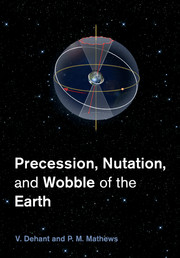Book contents
- Frontmatter
- Contents
- Preface
- List of abbreviations
- 1 Introduction – Fundamental definitions – Motivation
- 2 Concepts and elementary theory
- 3 Reference systems and frames
- 4 Observational techniques – ephemerides
- 5 Rigid Earth precession and nutation
- 6 Deformable Earth – Love numbers
- 7 Nutations of a non-rigid Earth
- 8 Anelasticity
- 9 Ocean and atmospheric corrections
- 10 Refinements of non-rigid nutation
- 11 Comparison observation-theory
- 12 Conventions
- 13 Mars nutations
- Appendix A Rotation representation
- Appendix B Clairaut theory
- Appendix C Definitions of equinoxes
- Bibliography
- Index
10 - Refinements of non-rigid nutation
Published online by Cambridge University Press: 05 May 2015
- Frontmatter
- Contents
- Preface
- List of abbreviations
- 1 Introduction – Fundamental definitions – Motivation
- 2 Concepts and elementary theory
- 3 Reference systems and frames
- 4 Observational techniques – ephemerides
- 5 Rigid Earth precession and nutation
- 6 Deformable Earth – Love numbers
- 7 Nutations of a non-rigid Earth
- 8 Anelasticity
- 9 Ocean and atmospheric corrections
- 10 Refinements of non-rigid nutation
- 11 Comparison observation-theory
- 12 Conventions
- 13 Mars nutations
- Appendix A Rotation representation
- Appendix B Clairaut theory
- Appendix C Definitions of equinoxes
- Bibliography
- Index
Summary
Most of the essential elements of the theory of nutation of the non-rigid Earth have been presented in Chapter 7. However a number of relatively small effects have to be taken into account before one can expect to have a theoretical framework that can yield numerical results that match the observational data on nutation and precession to approximately the same level of accuracy as the precision of the observations themselves.
The celebrated work of John Wahr (1979, 1981a–d) on the effects of the tidal potential on a rotating, ellipsoidal, elastic, and oceanless Earth led to numerical results for the coefficients of nutation for such an Earth model, as well as for the gravimetric factor and the various Love number parameters which represent various aspects of the deformational effects produced by the tidal potential. His numerical values for the coefficients of the 106 most important spectral components of the nutation were adopted as the IAU 1980 nutation series. The presence of the oceans on the actual Earth (and in particular, the effects of the ocean tides raised by the tidal potential) necessitates corrections to the results related to the above idealized model. The theory of the effects of the ocean tides (OT) raised by the tesseral potential (see Chapter 9), as developed by Sasao and Wahr (1981), was employed by Wahr and Sasao (1981) to obtain numerical results for the corrections. Studies on the influence of mantle an elasticity on Earth rotation variations (Wahr and Bergen, 1986, Dehant, 1987a and b) followed (see Chapter 8). The contributions to nutation amplitudes from both of these effects are not in phase with the tidal potential component responsible for the nutation and the contributions to certain amplitudes are rather large, of the order of a milliarcsecond. The influence of CMB topography was considered subsequently by Wu and Wahr (1997).
- Type
- Chapter
- Information
- Precession, Nutation and Wobble of the Earth , pp. 370 - 414Publisher: Cambridge University PressPrint publication year: 2015



